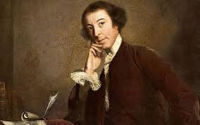Horace William, 4th Earl of Orford Walpole
Country
Great Britain
Birth - Death
1717 - 1797
Occupation
Politics, Writer
Description
The author who single-handedly created the Gothic novel genre, Horace Walpole also introduced the world to Gothic architecture through the creation of his palatial personal residence Strawberry Hill. Together, these styles of literature and architecture were deemed a reflection of his own perspective of a dysfunctional family life and, he stated, came to him through his dreams. In this context, Walpole introduced the modern concept of the house being a representation of the owner’s personality.
Born into the aristocracy of Great Britain’s first Prime Minister, Sir Robert Walpole, Horace was educated among the elite at Eton College and King’s College, Cambridge. This is where he met a group of fellow compatriots that formed his male friendships throughout life. Interpreters of his life waffle between his being asexual and homosexual, but all acknowledge the romantic influence and nature of his male friendships.
During his grand tour of Europe between 1739 and 1741 with this group of friends, Walpole gained an appreciation for the arts and literature of the continent. Upon his return, he successfully ran for parliament and held a seat for twenty seven years as a Whig (liberal) in three different ridings. Walpole became the 4th Earl of Orford in 1791 after his uncle passed away childless.
During his parliamentary career, Walpole commissioned the building of a remarkable villa in Twickenham dubbed Strawberry Hill in 1749. His design aesthetic introduced to the grand house the new Gothic style of architecture, complete with towers, turrets, stained glass, and battlements outside and elaborately carved decorations, armour, and silk wallpaper inside. He used a series of architects to create the masterpiece. It became one of the most influential buildings in the history of architecture and set a new standard for style. Its melancholic aesthetic outside was repeated in the interior to create an atmosphere of gloom and foreboding - ‘Gloomth’ was the word repeatedly used by Walpole in describing the house. This style incorporated the visual elements experienced in his grand tour.
The house drew an enormous number of visitors to marvel at its design and features and the style was soon repeated in new buildings. Walpole then followed up his Gothic architecture with a novel written from its inspiration. The Castle of Otranto (1764) is considered the original Gothic novel. The story is about a jealous prince who exercises his power through the abuse of men and women around him, with several early deaths and murders. The book was a reflection of Walpole’s own life, with a family beset by tragedy and its obsession with a Gothic castle. Walpole’s father, as known to all, had a mistress, and this deeply affected Horace Walpole in his youth.
Throughout his life, Horace Walpole is noted for living an effeminate, though charming, life. He never married and was described as pale and thin with a bright gaze. He had a secret on-again, off-again relationship with Henry Pelham-Clinton. His correspondence reveals a sense of romantic detachment.
This was also reflected in Horace Walpole’s defining characteristic as a great letter-writer of his generation. These are known today as masterpieces in writing style and the detail they convey. The letters have been described as subtle, witty, and oozing with gossip and vividly descriptive observation. With these writings, Walpole shows a keen eye on their posterity and how they would reflect, in history, his life and himself as a person. He had a keen desire to be remembered, and he ensured the safekeeping of his collection of correspondence in a meticulous manner to be sure they would be saved. Much as he saw Strawberry Hill as one of his great achievements in life, so too would be his writing.
Both, of course, were a reflection of a somewhat lonely life bereft of the intimacy of true love. They were created out of a desire to reflect on his personal life experiences, the agony of a same-sex desire that could not be fulfilled, and hence a lifetime of celibacy, conflicted with an outgoing social personality with a sickly, pale appearance. How often have we seen this situation repeated by talented LGBTQ individuals throughout history?

